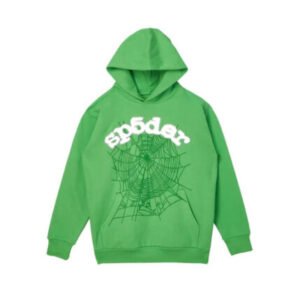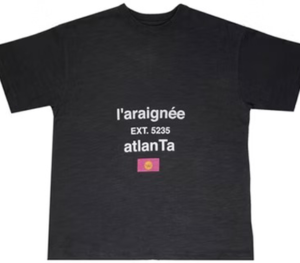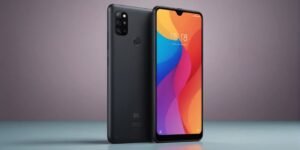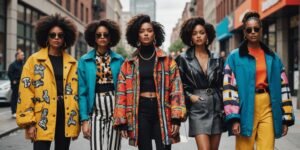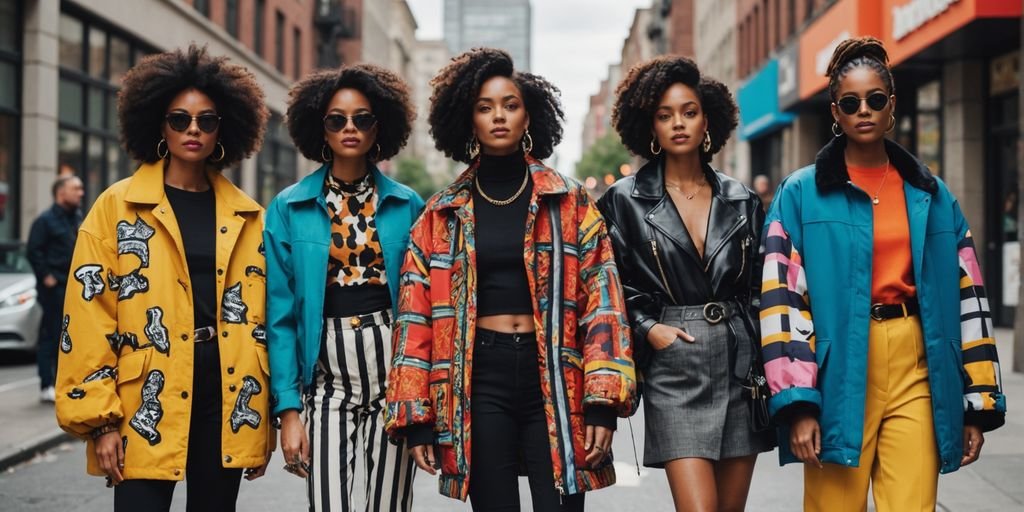
Exploring the Latest Trends in the Fashion World
Introduction:
Fashion is always changing, with new trends and ideas popping up all the time. From eco-friendly clothes to high-tech wearables, the fashion world is full of exciting developments. This article explores some of the latest trends that are shaping the future of fashion.
Key Takeaways
- Sustainable fashion is becoming more popular, focusing on eco-friendly materials and ethical production methods.
- Technology is transforming fashion with virtual fittings, augmented reality shopping, and AI-driven designs.
- Inclusivity and diversity are now key in fashion, with more gender-fluid, adaptive, and body-positive clothing lines.
- Vintage and retro styles are making a comeback, blending old-school charm with modern trends.
- Fashion influencers and social media play a big role in setting trends and promoting new styles.
Sustainable Fashion: A New Era of Conscious Consumption
Eco-Friendly Materials and Ethical Production
Sustainable fashion is becoming more important than ever. Eco-friendly materials like organic cotton, hemp, and bamboo are gaining popularity. These materials are grown without harmful pesticides, making them better for the environment. Ethical production means fair working conditions and no animal testing. This approach encourages consumers to buy fewer, high-quality items that last longer.
The Rise of Circular Fashion
Circular fashion is all about reusing and recycling. Instead of throwing clothes away, they are given a new life. This can be done through upcycling old garments or using recycled materials to create new ones. Circular fashion helps reduce waste and promotes a more sustainable lifestyle.
Consumer Demand for Transparency
Consumers today want to know where their clothes come from. They demand transparency in the supply chain, from how materials are sourced to how workers are treated. Brands that provide this information are gaining trust and loyalty from their customers. This shift shows that people are more conscious about their fashion choices and their impact on the world.
The Digital Transformation of the Fashion World
Virtual Fittings and Augmented Reality Shopping
Virtual fittings and augmented reality (AR) shopping are changing how we buy clothes. Consumers can now visualize how clothes would look on them without trying them on physically. This technology helps designers create virtual prototypes, making the design process faster and more efficient. AR shopping also offers a fun and interactive experience, attracting more customers to online stores.
Artificial Intelligence in Fashion Design
Artificial intelligence (AI) is revolutionizing fashion design. AI-powered tools help designers predict trends and understand consumer preferences. These tools analyze data to create designs that resonate with the target audience. AI also streamlines the production process, reducing costs and time. With AI, the fashion industry is becoming more innovative and efficient.
Blockchain for Supply Chain Transparency
Blockchain technology is enhancing transparency in the fashion supply chain. It allows brands to track the journey of their products from raw materials to the final product. This transparency builds trust with consumers who demand to know the origins of their purchases. Blockchain also helps in verifying the authenticity of luxury items, reducing the risk of counterfeits.
The digital transformation in fashion is not just about technology; it’s about creating a more sustainable and transparent industry. Digital fashion is a great solution when it comes to some of fashion’s sustainability and diversity issues.
Inclusivity and Diversity in Modern Fashion

Gender-Fluid and Unisex Collections
The boundaries of gender in fashion are becoming more fluid, with designers breaking away from traditional norms. Gender-neutral collections and unisex designs are gaining popularity, offering a more inclusive and diverse fashion landscape. Fashion-forward consumers are embracing styles that transcend gender stereotypes, empowering individuals to express their authentic selves through clothing and accessories.
Adaptive Clothing for People with Disabilities
Fashion is becoming more accessible with the rise of adaptive clothing designed for people with disabilities. These garments are not only functional but also stylish, ensuring that everyone can enjoy fashion without limits. Brands are increasingly focusing on creating adaptive clothing lines that cater to various needs, from easy-to-wear fastenings to sensory-friendly fabrics.
Representation of Various Body Types and Ethnicities
The fashion industry is celebrating diversity by featuring models of different body types, ethnicities, and ages. This shift towards inclusivity is evident in advertising campaigns, runway shows, and product lines. Consumers are demanding more representation, and brands are responding by showcasing a broader range of beauty standards. This movement is not just a trend but a significant step towards a more inclusive and representative fashion world.
The Resurgence of Vintage and Retro Styles
Nostalgic Fashion from Past Decades
Retro fashion refers to clothing, accessories, and styles inspired by trends from past decades. This nostalgic fashion from the ’70s, ’80s, and ’90s is making a big comeback. Designers are blending these classic looks with modern touches, creating unique and stylish outfits.
Thrifting and Second-Hand Shopping
Thrifting and second-hand shopping are becoming more popular. People love finding unique pieces and saving money. Plus, it’s a great way to be eco-friendly. Many brands are even starting their own resale marketplaces to join this trend.
Blending Classic and Modern Aesthetics
Fashion today often mixes old and new styles. This blend of classic and modern aesthetics creates fresh and exciting looks. By combining vintage pieces with contemporary designs, fashion becomes a fun way to express individuality.
The resurgence of vintage and retro styles shows how fashion is always evolving, yet often circles back to its roots.
The Influence of Fashion Influencers and Social Media
Power of Influencer Collaborations
Fashion influencers are a powerful tool for fashion brands. They can drive engagement, brand awareness, and ROI more effectively than other methods. Influencer collaborations often result in limited-edition collections that fans eagerly seek out. These partnerships allow brands to tap into the influencer’s loyal following, creating a direct line to potential customers.
Social Media as a Fashion Marketing Tool
Social media platforms have transformed how brands interact with customers. Live streaming, for example, allows brands to sell directly to consumers in real-time. This trend, known as ‘live commerce,’ is already popular in China and is expanding to Western markets. Social media also helps brands forecast trends by analyzing influencer and designer posts.
Trends Set by Online Personalities
Online personalities have a significant impact on fashion trends. They showcase their unique styles and endorse brands, making them trendsetters. Consumers look to these influencers for inspiration and guidance, making their endorsements a powerful marketing strategy. The influence of K-pop stars, for instance, has brought their fashion and culture to a global audience, affecting every industry, including fashion.
Artisanal Craftsmanship and Handmade Designs
In a world dominated by fast fashion, there’s a growing appreciation for artisanal craftsmanship and handmade designs. These unique pieces often reflect individuality and cultural heritage, offering a refreshing counterbalance to mass-produced fashion.
Appreciation for Unique, One-of-a-Kind Pieces
Consumers are increasingly drawn to items that are not only beautiful but also tell a story. Handcrafted accessories and garments carry a sense of authenticity and emotional connection. This trend is about more than just fashion; it’s about crafting a wardrobe by America’s finest artisans, creating heirloom-worthy pieces that stand the test of time.
Cultural Heritage in Fashion
Many handmade designs draw inspiration from traditional techniques and cultural motifs. These pieces often showcase the rich history and artistry of different cultures, making them not just fashion statements but also cultural artifacts. This connection to heritage adds depth and meaning to the items, making them cherished possessions.
Counterbalance to Mass-Produced Fashion
In an era where fast fashion dominates, handmade designs offer a much-needed alternative. These pieces are typically made with higher quality materials and greater attention to detail, ensuring they last longer and have less environmental impact. This shift towards quality over quantity is a key aspect of the slow fashion movement, encouraging consumers to invest in timeless, durable items rather than disposable trends.
Tech-Infused Wearables: The Future of Fashion

Smart Clothing and Accessories
The integration of technology and fashion is revolutionizing the industry with tech-infused wearables. Some of the latest innovations include smart clothing, such as jackets with built-in heating elements, and shoes with fitness-tracking capabilities. These items combine style and functionality, enhancing the user experience and promoting a more connected and convenient lifestyle.
Wearable Technology Enhancing Lifestyle
Wearable technology is blurring the lines between fashion and tech. From smartwatches to activity trackers, these devices are designed to be both stylish and practical. They offer a range of features that enhance daily life, such as monitoring health metrics and providing notifications. As the trend grows, designers are finding new ways to incorporate technology into their creations, making everyday wear more valuable and practical.
Fashion Meets Functionality
The fashion industry has greatly benefited from the discovery of wearable technology. This technology merges fashion and practicality to produce apparel and accessories that are both stylish and functional. Examples include garments with integrated sensors and accessories that can interact with other devices. As the athletic trend has grown, wearable technology has gained momentum, offering more valuable and practical apparel.
The future of fashion lies in the seamless integration of technology and style, creating a new standard for convenience and connectivity.
Conclusion
The fashion world is always changing, bringing new and exciting trends. From eco-friendly clothes to gender-neutral styles, the industry is finding ways to be more inclusive and responsible. Technology is also playing a big role, with virtual try-ons and smart wearables making shopping easier and more fun. As we look ahead, it’s clear that fashion will keep evolving, blending creativity with innovation to inspire and connect people everywhere.
Frequently Asked Questions
What is sustainable fashion?
Sustainable fashion focuses on creating clothes in a way that is kind to the environment and fair to workers. It includes using eco-friendly materials and ethical production methods.
How is technology changing the fashion industry?
Technology is making big changes in fashion through virtual fittings, augmented reality shopping, and using AI for design. Blockchain is also helping to make supply chains more transparent.
What does inclusivity in fashion mean?
Inclusivity in fashion means designing clothes for all body types, genders, and abilities. It also includes representing different ethnicities and cultures.
Why are vintage and retro styles popular again?
Vintage and retro styles are making a comeback because people love the nostalgic feel and unique look. Thrifting and second-hand shopping are also more popular, which helps the environment.
How do fashion influencers impact trends?
Fashion influencers set trends by sharing their styles on social media. Their followers often look to them for inspiration, making influencers powerful in shaping fashion.
What are tech-infused wearables?
Tech-infused wearables are clothes and accessories that have technology built into them, like smartwatches or jackets with heating elements. They combine fashion with practical tech.
